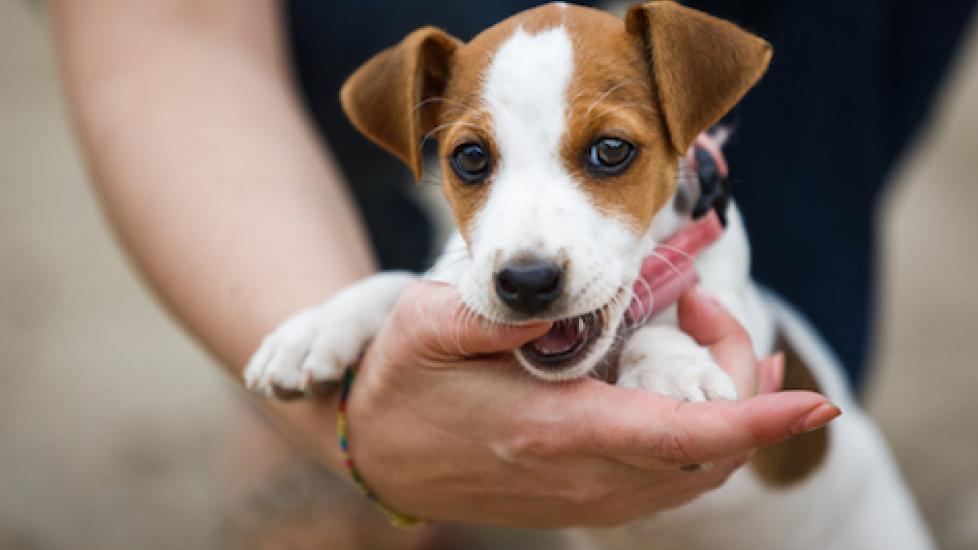How To Find, Treat, and Prevent Fleas on Puppies
Nearly every pet parent has had to deal with the dreaded F word: fleas. These pesky parasites can cause excessive chewing, scratching, and licking in dogs. In severe cases, flea infestations can lead to a host of medical conditions, including anemia, tapeworms, hot spots, and bacterial infections.
Puppies are especially vulnerable to these flea-related health issues, says Dr. Judy Morgan, a New Jersey-based holistic veterinarian. Even a mild to moderate flea infestation can put their health at risk. Because of their small size and immature physiology, puppies have a greater chance of developing anemia, she says, which can cause weakness, respiratory distress, and even death.
Fortunately, you can tackle the problem head-on with a little prevention and a thorough home cleaning. Here’s how to find, treat, and prevent fleas on puppies.
Finding Fleas on Puppies
“Spotting fleas early is important in keeping your puppy safe and preventing a full-blown infestation,” says Dr. Rob Hance of Sunset Animal Clinic in Houston. Flea bites commonly appear as small red bumps or scabs on the body.
A flea comb will help you find the fleas themselves, as well as any debris they leave behind. While you’re grooming your pup, look for symptoms of fleabite dermatitis, Hance says. This occurs when a dog is allergic to flea saliva.
“Puppies with fleabite dermatitis will scratch excessively and may develop red, irritated and infected patches of skin called hot spots,” he says.
More extreme symptoms of a flea infestation can include weight loss, pale gums, and lethargy. Morgan recommends checking your dog up to three times per day for flea activity.
If you suspect your puppy has a flea problem, or if your pup exhibits any concerning symptoms, take them to the veterinarian right away, Hance advises. A doctor can confirm the infestation and prescribe proper age-appropriate treatment.
Treating a Puppy With Fleas
Treating a puppy immediately and regularly will help stop the infestation and prevent flea-related health complications.
Bathing your puppy with Dawn dish soap can help get rid of fleas. For puppies over 12 weeks old, you can use a flea shampoo formulated for young animals to alleviate some flea-related skin irritations. This will also remove the adult fleas living in your pup’s fur.
But flea shampoo doesn’t kill flea larvae or remove their eggs, so prescription flea and tick medication may be necessary.
Talk to your vet before applying any kind of prescription or over-the-counter treatment. Many of the common chemicals used in flea medications are too harsh for puppies, Morgan says. Some are even neurotoxins, which can harm a puppy’s developing nervous system.
Also, puppies love to lick and chew. This means anything you put on them will end up in their mouths, she says, especially if you have multiple puppies climbing and gnawing on each other.
Your veterinarian will be able to recommend a safe product for your dog. Some commonly prescribed flea preventatives for puppies can be used for dogs as young as 4–6 weeks old.
Getting Rid of Fleas in Your Home
Remember: Fleas only live on their host 5% of the time. The rest of the time they’re making their home in your carpets and couches, Morgan says. “Treating the puppies without treating the environment is futile,” she says.
The need for aggressive environmental controls may be only temporary, though. As you pup matures, you can consider using more powerful flea preventive medications that can do an excellent job of preventing infestations all on their own.
Some natural flea repellent products include food-grade diatomaceous earth, a natural pest control powder, and beneficial nematodes, which kill fleas and their larvae, Morgan says.
Give your house a good cleaning to remove any eggs or larvae embedded in your carpet, rugs, and furniture. Vacuum all floors and furniture that have upholstery or padding, Hance adds, and throw the vacuum bag out immediately.
“Don’t forget to wash your bedding, as well as your puppy’s bedding, in hot, soapy water to make sure all flea larvae and eggs are wiped out,” Hance says.
It can also be helpful to treat your yard for fleas to prevent future infestations, Hance says. He recommends placing sage, rosemary, basil, mint, or lemongrass plants near your front and back doors to keep fleas at bay.
Preventing Fleas From Coming Back
The hardest part of preventing a flea issue from coming back is getting all of the pets, the home, and the yard all treated at the same time. To do so, you must treat all life stages of the flea so they cannot return.
Kill Existing Fleas
To do so, you need to first do one of two things:
-
Give your puppy Capstar, a tablet that kills all live fleas in pups over 4 weeks old.
-
Bathe your puppy in Dawn dish soap to kill all live fleas.
Begin Flea Prevention
At the same time, you must use flea prevention methods, such as Revolution for puppies.
Clean the Environment
While you treat your pets, it’s important to keep them confined in a small, tiled room (such as a bathroom or laundry room), so you can clean the pet's environment.
By Helen Anne Travis
Featured Image: iStock/castenoid
